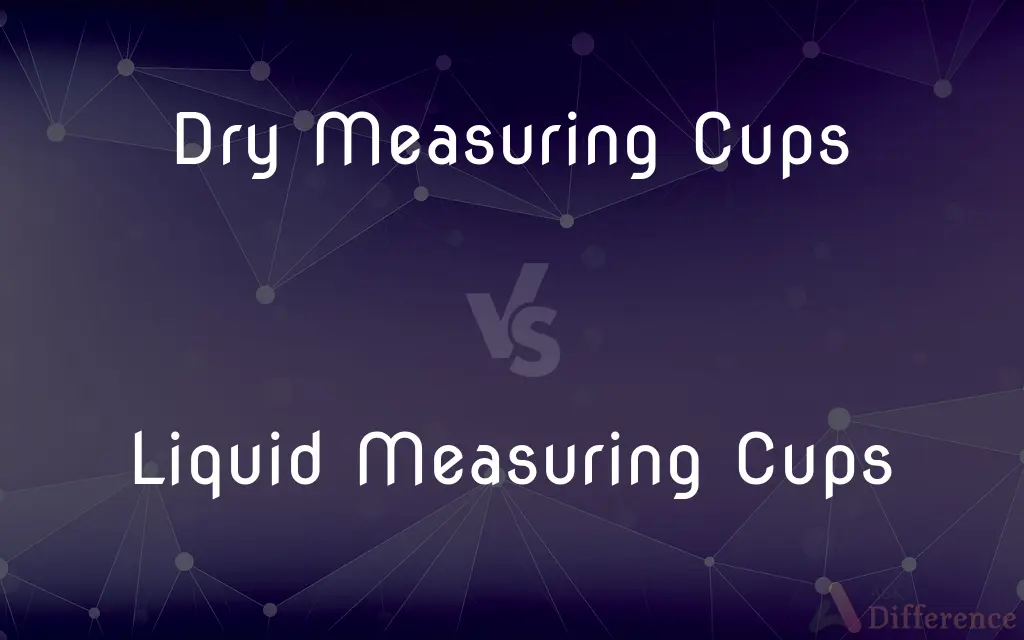Dry Measuring Cups vs. Liquid Measuring Cups — What's the Difference?
Edited by Tayyaba Rehman — By Fiza Rafique — Published on November 4, 2023
Dry Measuring Cups are designed for measuring solid ingredients, while Liquid Measuring Cups are for liquids, with a pour spout and extra space at the top.

Difference Between Dry Measuring Cups and Liquid Measuring Cups
Table of Contents
ADVERTISEMENT
Key Differences
Dry Measuring Cups are specifically designed to measure dry ingredients like flour, sugar, and grains. They typically come in a set, with different sizes such as 1/4 cup, 1/3 cup, 1/2 cup, and 1 cup. The top edge is straight, allowing ingredients to be leveled off for precise measurements. In contrast, Liquid Measuring Cups are intended for measuring liquids like water, oil, and milk. These cups have graduated markings on the side, usually in both milliliters and ounces.
When using Dry Measuring Cups, one fills the ingredient up to the top and then levels it off with a flat edge, ensuring a precise amount. This method would be inefficient and messy with Liquid Measuring Cups. On the other hand, Liquid Measuring Cups are designed with extra space above the highest measurement marking to prevent spills when pouring.
Materials and design also distinguish Dry Measuring Cups from Liquid Measuring Cups. Dry cups are often made of plastic or metal and come as individual cups for each measurement. Liquid cups, however, are usually made of glass or clear plastic and feature a spout for easy pouring.
In cooking and baking, the distinction between Dry Measuring Cups and Liquid Measuring Cups is vital. While it might seem minor, using the wrong type of cup can lead to inaccurate measurements, affecting the outcome of a recipe.
Comparison Chart
Purpose
For measuring dry ingredients
For measuring liquid ingredients
ADVERTISEMENT
Design
Individual cups, straight edges
Single container, pour spout, graduated markings
Leveling
Ingredients leveled off for accuracy
No leveling, use markings
Material
Often plastic or metal
Typically glass or clear plastic
Typical Set Components
1/4 cup, 1/3 cup, 1/2 cup, 1 cup
Single cup with multiple markings
Compare with Definitions
Dry Measuring Cups
Dry Measuring Cups are integral for accurate baking.
For the best cookies, always measure the cocoa using Dry Measuring Cups.
Liquid Measuring Cups
Liquid Measuring Cups often have extra space to prevent spillage.
Thanks to the additional space, her Liquid Measuring Cups never overflow when she's measuring.
Dry Measuring Cups
Dry Measuring Cups come in a set with varying sizes.
His set of Dry Measuring Cups includes four different sizes for versatile cooking.
Liquid Measuring Cups
Liquid Measuring Cups feature graduated markings for varied measurements.
The clear markings on the Liquid Measuring Cups ensured she added the right amount of broth.
Dry Measuring Cups
Dry Measuring Cups are designed for precision with straight edges.
Using the straight edge of a knife, he leveled the sugar in the Dry Measuring Cups.
Liquid Measuring Cups
Liquid Measuring Cups are designed to measure liquid volumes.
She poured the milk into the Liquid Measuring Cups, noting the quantity.
Dry Measuring Cups
Dry Measuring Cups are tools for gauging solid ingredients.
She scooped flour into the Dry Measuring Cups and then leveled it off.
Liquid Measuring Cups
Liquid Measuring Cups have a spout for convenient pouring.
Using the spout on his Liquid Measuring Cups, he carefully added oil to the pan.
Dry Measuring Cups
Dry Measuring Cups can be made from different materials.
Her stainless steel Dry Measuring Cups are both durable and sleek.
Liquid Measuring Cups
Liquid Measuring Cups are usually transparent for better visibility.
The transparency of the Liquid Measuring Cups allowed her to see the exact level of the juice.
Common Curiosities
Are Liquid Measuring Cups typically transparent?
Yes, they're usually made of glass or clear plastic for better visibility of the liquid's level.
Can I interchange them in recipes?
It's not recommended, as it can lead to inaccurate measurements and affect the recipe outcome.
How do I get an accurate measurement with Dry Measuring Cups?
Fill the ingredient to the top and level it off with a flat edge.
How do Liquid Measuring Cups differ?
Liquid Measuring Cups are designed for liquids and have a pour spout and graduated markings.
Do I need both types of measuring cups in my kitchen?
For best results in cooking and baking, it's recommended to have both types.
Why do Dry Measuring Cups come in a set?
Different recipes require different amounts, and a set offers a range of sizes for various needs.
What are Dry Measuring Cups used for?
Dry Measuring Cups are used to measure solid or dry ingredients like flour, sugar, and grains.
Are there materials I should avoid for these cups?
Some prefer to avoid plastic due to concerns about chemicals, but it's a personal choice.
Do the materials of the cups affect the measurement's accuracy?
No, but durability and longevity might differ between materials.
Why do Liquid Measuring Cups have extra space at the top?
The extra space helps prevent spills when pouring or moving the cup.
Can I use Dry Measuring Cups for liquids if I'm careful?
It's possible, but not advised, as there's a higher chance of inaccuracies.
How should I clean and store these measuring cups?
Both types can usually be washed in a dishwasher and should be stored in a dry place.
Can I use a scale instead of measuring cups?
Yes, many professional bakers use scales for precision, but measuring cups are more convenient for home cooks.
Why are precise measurements so important in baking?
Baking is a science, and accurate measurements ensure the correct balance of ingredients for the desired outcome.
How can I ensure my Liquid Measuring Cups remain accurate over time?
Avoid rough handling, which might wear off the markings, and replace them if they become unclear.
Share Your Discovery

Previous Comparison
Prunes vs. Dates
Next Comparison
Pleural Effusion vs. PneumoniaAuthor Spotlight
Written by
Fiza RafiqueFiza Rafique is a skilled content writer at AskDifference.com, where she meticulously refines and enhances written pieces. Drawing from her vast editorial expertise, Fiza ensures clarity, accuracy, and precision in every article. Passionate about language, she continually seeks to elevate the quality of content for readers worldwide.
Edited by
Tayyaba RehmanTayyaba Rehman is a distinguished writer, currently serving as a primary contributor to askdifference.com. As a researcher in semantics and etymology, Tayyaba's passion for the complexity of languages and their distinctions has found a perfect home on the platform. Tayyaba delves into the intricacies of language, distinguishing between commonly confused words and phrases, thereby providing clarity for readers worldwide.












































